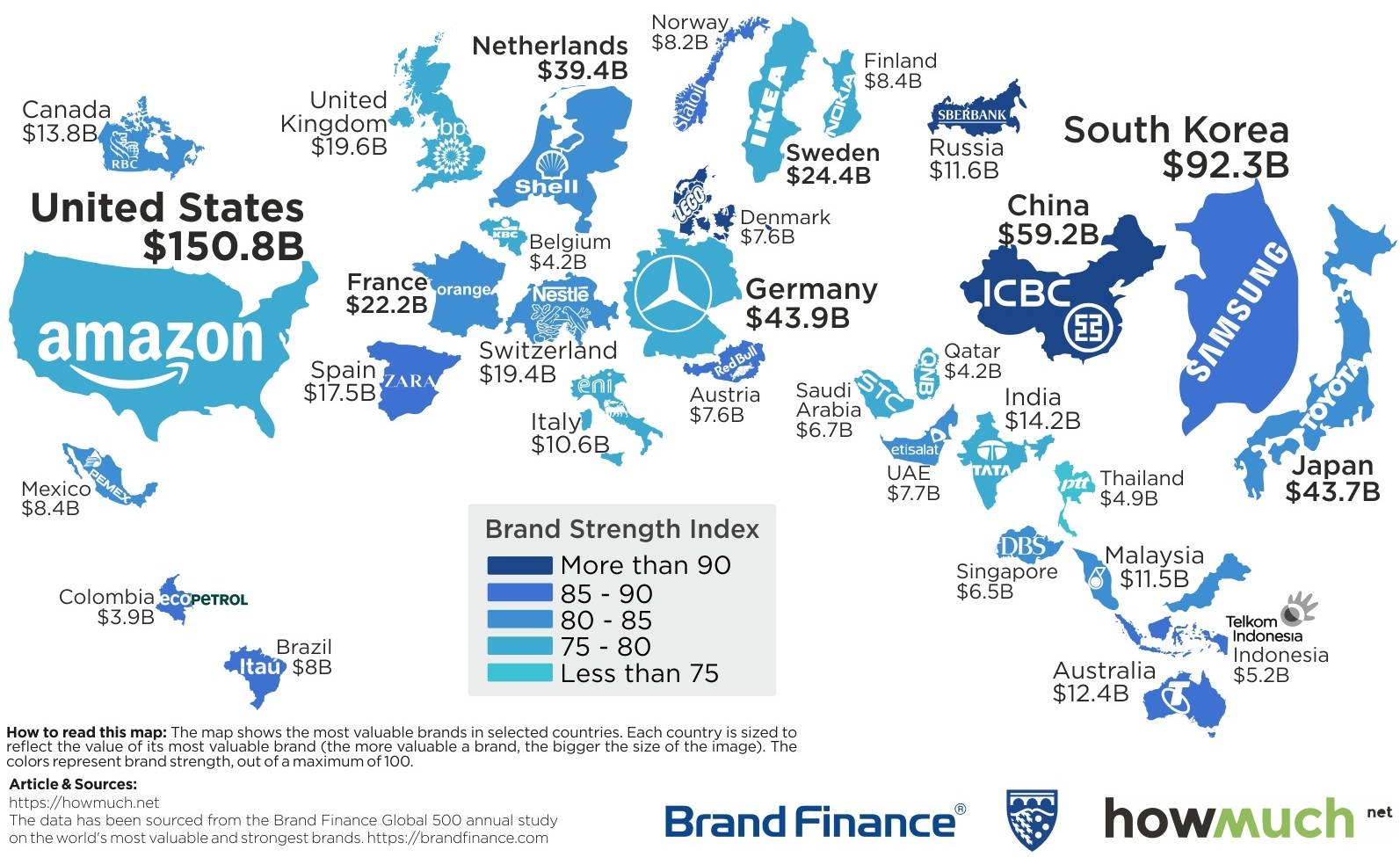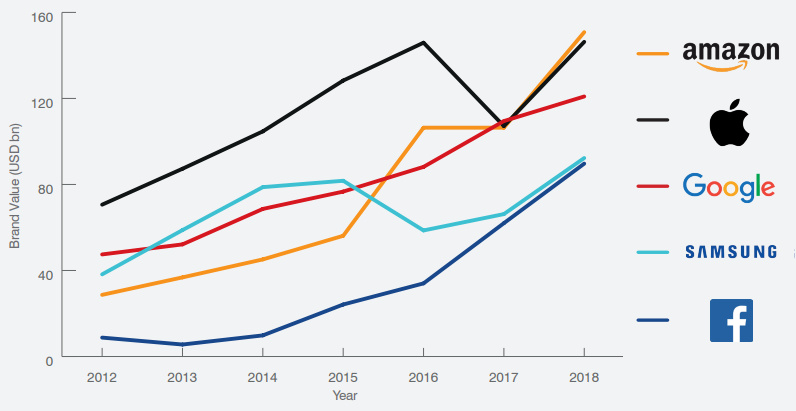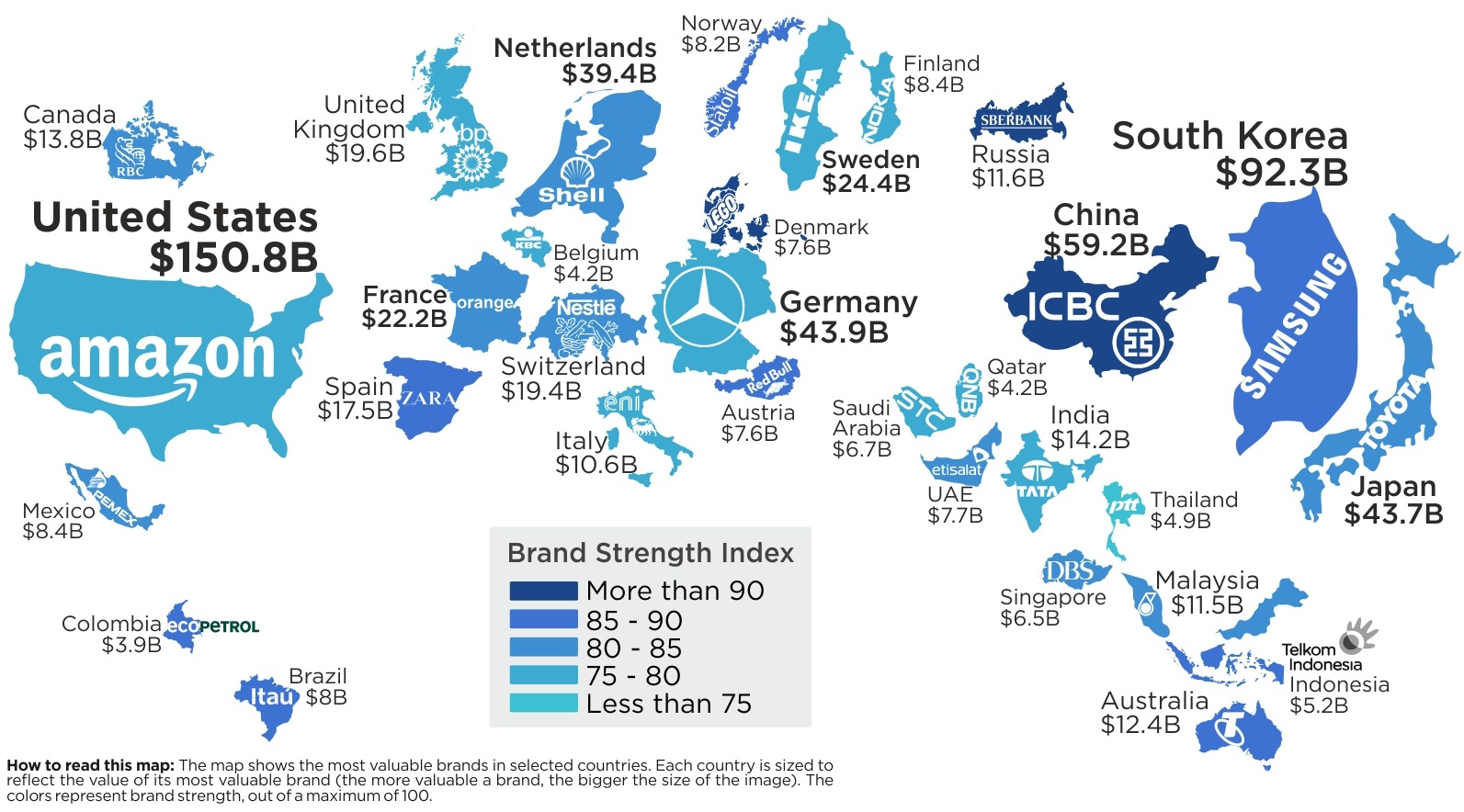Technology
The Most Valuable Brand in Each Country in 2018

Map: The Most Valuable Brand in Each Country in 2018
Last year, we covered the world’s top brands based on the measure of brand value, and one thing stood out.
The top of the list was dominated by U.S. brands like Google, Amazon, Facebook, Visa, AT&T, and McDonald’s, but only one non-American brand (China’s Tencent) was able to crack the top 10 list.
Today’s infographic comes to us from HowMuch.net, and it helps to make the international brand value picture a lot clearer. Using updated rankings from Brand Finance’s Global 500 Report, it shows the top brand for each country in 2018.
It’s worth noting, however, that there are many countries that are not represented here, as they do not have a brand large enough to make the top 500 list.
A Steep Dropoff
Keeping the aforementioned U.S. dominance of brands in mind, there is a pretty steep drop from the U.S. to other countries on the map. After retail giant Amazon, which ranks as the world’s top brand at $150.8 billion, the next biggest brand in any other country is Samsung (South Korea) at $92.3 billion.
From there, it’s another big fall to get to the next tier, which includes China’s ICBC ($59.2 billion), Germany’s Mercedes-Benz ($43.9 billion), Japan’s Toyota ($43.7 billion), and Royal Dutch Shell ($39.4 billion).
After that, the remaining brands on the list are in the $4 billion to $25 billion range, including well-known names like Nestlé ($19.4 billion), Zara ($17.5 billion), and RBC ($13.8 billion). While small compared to Amazon, these are still mostly large international or national brands.
Why is Amazon so Dominant?
As Amazon continues to rapidly scale its revenue, and as the Jeff Bezos Empire expands, we are all now very familiar with the online retailer’s dominance.
That said, while Amazon appears massive on the map, it actually only just edged out Apple as the most dominant brand overall. Further, because Apple is also based in the U.S., the iconic tech company doesn’t have its logo appear on the map itself.
Here’s a look at how brand value for the top five brands has changed over time:

Courtesy: Brand Finance
According to Brand Finance, the value of Amazon’s brand increased by 42% between 2017 and 2018. Here’s what Brand Finance CEO, David Haigh, had to say about the future of Amazon’s brand:
The strength and value of the Amazon brand gives it stakeholder permission to extend relentlessly into new sectors and geographies. All evidence suggests that the amazing Amazon brand is going to continue growing indefinitely and exponentially.
– David Haigh, CEO of Brand Finance
Interestingly, the report authors also offer up reasons for Apple and Google getting “left behind”.
For Apple, an over-dependency on the iPhone limits the brand’s growth opportunities, while Google’s investments outside of search are unable to offer the scale, impact, or audacity demonstrated by Amazon’s ventures.
A Note on Brand Value
Understandably, there is often some confusion behind the definition of “brand value”.
Not to be confused with market capitalization or enterprise value, brand value is defined as a marketing-related intangible asset that generates economic benefits for a brand within a company. In other words, this is the value of the image of the brand itself, as represented in the minds of stakeholders.
Technology
Ranked: Semiconductor Companies by Industry Revenue Share
Nvidia is coming for Intel’s crown. Samsung is losing ground. AI is transforming the space. We break down revenue for semiconductor companies.
Semiconductor Companies by Industry Revenue Share
This was originally posted on our Voronoi app. Download the app for free on Apple or Android and discover incredible data-driven charts from a variety of trusted sources.
Did you know that some computer chips are now retailing for the price of a new BMW?
As computers invade nearly every sphere of life, so too have the chips that power them, raising the revenues of the businesses dedicated to designing them.
But how did various chipmakers measure against each other last year?
We rank the biggest semiconductor companies by their percentage share of the industry’s revenues in 2023, using data from Omdia research.
Which Chip Company Made the Most Money in 2023?
Market leader and industry-defining veteran Intel still holds the crown for the most revenue in the sector, crossing $50 billion in 2023, or 10% of the broader industry’s topline.
All is not well at Intel, however, with the company’s stock price down over 20% year-to-date after it revealed billion-dollar losses in its foundry business.
| Rank | Company | 2023 Revenue | % of Industry Revenue |
|---|---|---|---|
| 1 | Intel | $51B | 9.4% |
| 2 | NVIDIA | $49B | 9.0% |
| 3 | Samsung Electronics | $44B | 8.1% |
| 4 | Qualcomm | $31B | 5.7% |
| 5 | Broadcom | $28B | 5.2% |
| 6 | SK Hynix | $24B | 4.4% |
| 7 | AMD | $22B | 4.1% |
| 8 | Apple | $19B | 3.4% |
| 9 | Infineon Tech | $17B | 3.2% |
| 10 | STMicroelectronics | $17B | 3.2% |
| 11 | Texas Instruments | $17B | 3.1% |
| 12 | Micron Technology | $16B | 2.9% |
| 13 | MediaTek | $14B | 2.6% |
| 14 | NXP | $13B | 2.4% |
| 15 | Analog Devices | $12B | 2.2% |
| 16 | Renesas Electronics Corporation | $11B | 1.9% |
| 17 | Sony Semiconductor Solutions Corporation | $10B | 1.9% |
| 18 | Microchip Technology | $8B | 1.5% |
| 19 | Onsemi | $8B | 1.4% |
| 20 | KIOXIA Corporation | $7B | 1.3% |
| N/A | Others | $126B | 23.2% |
| N/A | Total | $545B | 100% |
Note: Figures are rounded. Totals and percentages may not sum to 100.
Meanwhile, Nvidia is very close to overtaking Intel, after declaring $49 billion of topline revenue for 2023. This is more than double its 2022 revenue ($21 billion), increasing its share of industry revenues to 9%.
Nvidia’s meteoric rise has gotten a huge thumbs-up from investors. It became a trillion dollar stock last year, and broke the single-day gain record for market capitalization this year.
Other chipmakers haven’t been as successful. Out of the top 20 semiconductor companies by revenue, 12 did not match their 2022 revenues, including big names like Intel, Samsung, and AMD.
The Many Different Types of Chipmakers
All of these companies may belong to the same industry, but they don’t focus on the same niche.
According to Investopedia, there are four major types of chips, depending on their functionality: microprocessors, memory chips, standard chips, and complex systems on a chip.
Nvidia’s core business was once GPUs for computers (graphics processing units), but in recent years this has drastically shifted towards microprocessors for analytics and AI.
These specialized chips seem to be where the majority of growth is occurring within the sector. For example, companies that are largely in the memory segment—Samsung, SK Hynix, and Micron Technology—saw peak revenues in the mid-2010s.
-

 Real Estate2 weeks ago
Real Estate2 weeks agoVisualizing America’s Shortage of Affordable Homes
-

 Technology1 week ago
Technology1 week agoRanked: Semiconductor Companies by Industry Revenue Share
-

 Money2 weeks ago
Money2 weeks agoWhich States Have the Highest Minimum Wage in America?
-

 Real Estate2 weeks ago
Real Estate2 weeks agoRanked: The Most Valuable Housing Markets in America
-

 Business2 weeks ago
Business2 weeks agoCharted: Big Four Market Share by S&P 500 Audits
-

 AI2 weeks ago
AI2 weeks agoThe Stock Performance of U.S. Chipmakers So Far in 2024
-

 Misc2 weeks ago
Misc2 weeks agoAlmost Every EV Stock is Down After Q1 2024
-

 Money2 weeks ago
Money2 weeks agoWhere Does One U.S. Tax Dollar Go?












